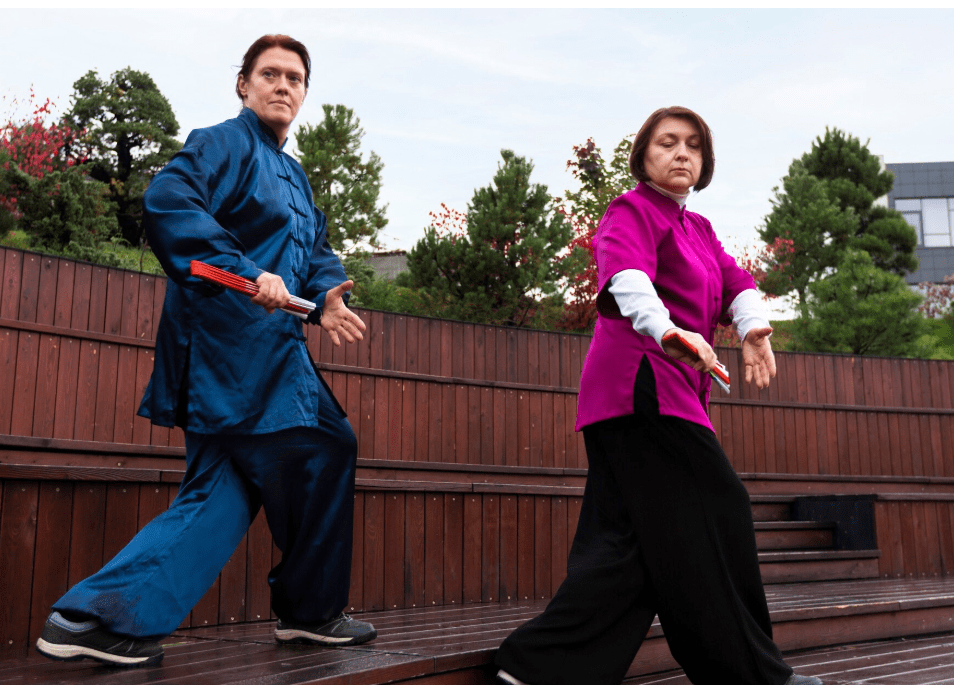Despite its calm demeanor, tai chi walking is subtly changing people’s perceptions about exercise and weight loss. It encourages balance between breath, posture, and intentional steps rather than pursuing intensity. By doing this, it opens up advantages that go much beyond just burning calories.

A groundbreaking study in Hong Kong including over 370 middle-aged adults demonstrated a surprisingly equal effectiveness between Tai Chi and conventional walking for weight loss. People who practiced Tai Chi dropped an average of 0.5 kg of weight and 3.7 cm from their waists throughout a 12-week period. Walkers performed marginally better, losing 0.76 kg of weight and 4.1 cm of waist circumference. Despite appearing small on paper, these results show low-risk and sustainable outcomes, which are especially helpful for people who were previously shut out of high-impact programs.
Tai Chi Walking – Key Information for Weight Loss
| Element | Details |
|---|---|
| Exercise Type | Moderate-intensity, low-impact movement combining Tai Chi forms with walking |
| Duration Recommended | 45 minutes daily, 5 times per week |
| Target Demographic | Middle-aged adults, beginners, individuals with joint issues or seeking mindful movement |
| Notable Outcomes | Up to 0.76 kg weight loss, reduced waistline, lower fasting blood glucose |
| Additional Benefits | Stress relief, improved coordination, better sleep, enhanced metabolic function |
| Equipment Needed | None (optional: loose clothing and soft-soled shoes) |
| Research Backing |
Tai Chi movements use deliberate, slow transitions and muscle control to activate specific muscle areas, which slowly increases metabolic activity. Forms like “Brush Knee” and “Part the Wild Horse’s Mane,” which employ gravity and controlled resistance to increase strength, are especially notable for this effect. Resting energy expenditure rises in tandem with muscle tone. It’s a method that steadily but gradually increases efficiency.
More significantly, Tai Chi reconditions the mind in addition to changing the physical form. It has been demonstrated that practicing these flowing patterns lowers cortisol, the stress hormone frequently connected to obstinate abdominal fat. This emotional reset is a wonderfully powerful technique for both physical and psychological wellness in a culture that is overstimulated and where burnout is common. More controlled hunger, healthier eating habits, and less emotional eating episodes are all results of a calmer mind, demonstrating a positive impact that extends far beyond exercise.
Tai Chi walking’s modest yet constant movement patterns are very creative in the way they enhance coordination and balance. Research has indicated significant improvements in several domains, particularly in elderly folks and individuals recuperating from injuries. Strengthened proprioception makes other activities—like riding, swimming, or even gardening—more accessible. It promotes “movement confidence,” which many trainers refer to as the cornerstone of active aging.
Additionally, Tai Chi practitioners report much better sleep quality. Better sleep is clinically associated with more constant levels of the hormones ghrelin and leptin, which are crucial for controlling appetite and fat storage. Without the use of medicine, this biological reset can help maintain long-term weight control and drastically lessen cravings at night.
Tai Chi walking is more of a fluid dialogue between the body and breath than it is a rigid set of rules. The “White Crane Spreads Wings” motion, for example, moves the foot forward gently while the arms sweep upward in a sweeping arc. The beat quietly increases physical endurance while calming the nervous system and promoting inner peace. These sequences are very inclusive and versatile because they can be practiced alone, in a group, or even modified for indoor routines.
Tai Chi is becoming more and more popular among celebrities who are concerned about their health. Tai Chi has been credited by Hollywood stars such as Keanu Reeves and Robert Downey Jr. with helping them with their emotional grounding, awareness, and posture during physically taxing filming. Their tacit support is indicative of a larger trend toward mindful fitness, where longevity and ease of integration into daily life are used to gauge impact rather than intensity.
Tai Chi walking represents a generational shift in society. Disillusioned by the deterioration of aggressive gym culture, millennials and Gen Xers are adopting forms that put an emphasis on internal reward and sustainability. Because of this change, yoga, barre, and now tai chi are not only common but also valued in society. Fitness’s image is changing from one of sweaty fury to one of graceful efficiency.
Even medical professionals are starting to see the possibilities for public health. In some regions of China and the United States, insurance-backed wellness programs increasingly incorporate Tai Chi as a fall, hypertension, and chronic tiredness prevention strategy. It’s easy to understand why: the benefits are incredibly long-lasting, the risks of damage are negligible, and the costs are minimal.
The accessibility of Tai Chi walking is one of its best features. It doesn’t require a gym, technology, or prior athletic experience. It provides a warm, welcoming entryway into the discipline of movement for anyone recuperating from an injury, going through burnout, or just not knowing where to begin. Additionally, there is an innate lyrical element to forms like “Play the Pipa” and “Grasp the Bird’s Tail” that transforms the experience from a workout routine into a work of art in motion.
The question of whether such mild exercise can actually aid in fat loss is frequently raised. Yes, according to the evidence, but not in the fast-paced manner of spin or CrossFit classes. Rather, Tai Chi walking creates a metabolic state that is especially conducive to long-term transformation. Its effects are modest but significant and include decreased fasting blood glucose, decreased belly fat, and increasing energy levels.
Tai Chi’s dual focus is what really makes it unique. It balances extremes rather than chasing them. It soothes the agitated mind with its focused breathing and contemplative posture. It awakens and reshapes the body with its planned phases and sequences. And in that blend, it achieves something particularly innovative: a weight-loss strategy that is compassionate, extremely efficient, and emotionally anchoring.
